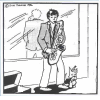Friday, June 10, 2005
New animals and an old bird!
 The much maligned borderline science of cryptozoology is having a bumper year so far, with the discovery of two significant new species of mammal, and the news that the ivory-billed woodpecker also appears to have survived!
The much maligned borderline science of cryptozoology is having a bumper year so far, with the discovery of two significant new species of mammal, and the news that the ivory-billed woodpecker also appears to have survived!The ivory-billed woodpecker is a large, iconic American bird that I remember seeing in books of rare (or extinct) creatures when I was a kid. The last confirmed sighting was 40 years ago. It's evidently an elusive species, left now only thinly distributed in the Big Woods region of eastern Arkansas. Previous sightings, which were almost invariably attributed to the pileated woodpecker, it seems, should have been believed.
 In May, came the news that a new rodent, the kha-nyou, had been discovered for sale at an Asian food market, by scientist Robert Timmins (Wildlife Conservation Society, New York City). As is usual in these cases, the locals - people of the Khammouan region of Laos - have always been familiar with the animal. It's a large rodent - around 40 cm from nose to tail - and appears to be related to South American rodents, such as guinea pigs and chinchillas, though it's not closely related to any other rodents and has been assigned its own family. As with the Vu Quang ox (a kind of goat-antelope discovered in Vietnam), it seems to be an important member of its order, providing critical information about evolution and spread of its relatives.
In May, came the news that a new rodent, the kha-nyou, had been discovered for sale at an Asian food market, by scientist Robert Timmins (Wildlife Conservation Society, New York City). As is usual in these cases, the locals - people of the Khammouan region of Laos - have always been familiar with the animal. It's a large rodent - around 40 cm from nose to tail - and appears to be related to South American rodents, such as guinea pigs and chinchillas, though it's not closely related to any other rodents and has been assigned its own family. As with the Vu Quang ox (a kind of goat-antelope discovered in Vietnam), it seems to be an important member of its order, providing critical information about evolution and spread of its relatives. Mostly recently (also in May) came the announcement of the discovery of the highland mangabey, a new species of monkey. It's apparently slightly larger than a baboon, with long cheek whiskers and a tall crest on its head (see picture), and it makes a distinctive call. Of course, it's in low numbers, and living in an isolated location - the Udzungwa Mountains of Tanzania - which is what has enabled it to survive this long. In this case it was apparently so isolated that even the locals were unaware of its existence!
Mostly recently (also in May) came the announcement of the discovery of the highland mangabey, a new species of monkey. It's apparently slightly larger than a baboon, with long cheek whiskers and a tall crest on its head (see picture), and it makes a distinctive call. Of course, it's in low numbers, and living in an isolated location - the Udzungwa Mountains of Tanzania - which is what has enabled it to survive this long. In this case it was apparently so isolated that even the locals were unaware of its existence!Dr. Karl Shuker, author of The Lost Ark and The New Zoo, large books which compile new and rediscovered animals, will have to get busy with a new edition...
I always hope that new discoveries will lead to appropriate conservation efforts, and don't represent cases of animals being found because the last wildernesses are about to disappear!
Images & Sources:
Labels: birds, cryptozoology, new animals, new birds, new species
Comments:
I was lucky enough to sight a huge woodpecker on one of my trips to Canada. Can't remeber the name, but I think it had some red markings. Gotta love that sound they make when they're pecking away.
Also What part are you refering to in the bill peet book? What's this well known book you also mention. Not sure if you can get the one I mentioned (Cartoon Charlie) but is also a great read with lots of good pics.
Also What part are you refering to in the bill peet book? What's this well known book you also mention. Not sure if you can get the one I mentioned (Cartoon Charlie) but is also a great read with lots of good pics.
Wow, I'm curious about that woodpecker - will have a look in my bird-books...
Details of that book:
Disney Animation: the Illusion of Life by Frank Thomas & Ollie Johnston
Abbeville Press, 1981 (reprinted 1984)
ISBN: 089659498X
Cover picture at: http://www.redskybooks.net/rsb455/images/items/012038.jpg
It's apparently become a bit rare and valuable (with an inferior reprint edition around as well), but your local library will probably have a copy.
This book has excellent information about the early Disney animators, including Norm Ferguson, Bill Tytla, etc. Bill Peet may not have thought much of Frank Thomas but this book is well worth reading in any case (as is Peet's).
Post a Comment
Details of that book:
Disney Animation: the Illusion of Life by Frank Thomas & Ollie Johnston
Abbeville Press, 1981 (reprinted 1984)
ISBN: 089659498X
Cover picture at: http://www.redskybooks.net/rsb455/images/items/012038.jpg
It's apparently become a bit rare and valuable (with an inferior reprint edition around as well), but your local library will probably have a copy.
This book has excellent information about the early Disney animators, including Norm Ferguson, Bill Tytla, etc. Bill Peet may not have thought much of Frank Thomas but this book is well worth reading in any case (as is Peet's).

